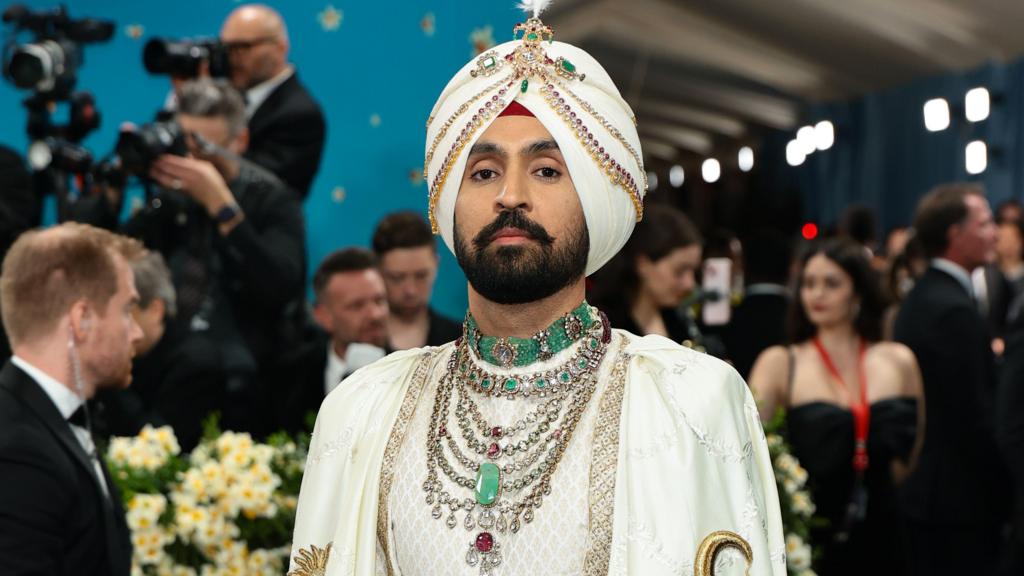Diljit Dosanjh’s Met Gala appearance last month made a significant impact on the global fashion scene.
The 41-year-old singer, the only Punjabi musician to perform at Coachella, graced the red carpet in a stunning early 20th-century maharajah-inspired ensemble.
His opulent ivory and gold outfit, designed by Prabal Gurung, featuring a jeweled feathered turban, was a trending sensation in India for weeks.
He complemented the look with a magnificent diamond necklace, inspired by a Cartier piece worn by a former king of Punjab.
A Panthère de Cartier watch, a lion-headed jeweled sword, and a cape embroidered with a map of Punjab and Gurmukhi script completed his regal look.
This bold style is consistent with Dosanjh’s established aesthetic.
His fashion sense mirrors his music, blending traditional Punjabi styles with Western influences. His signature look—often featuring loose-fitting trousers, chunky sneakers, layered necklaces, and colorful turbans—has captivated millions, inspiring innovative reinterpretations of traditional Punjabi attire.
This influence is widespread. High-energy bhangra competitions in California necessitate performance-ready sneakers, while Berlin’s underground bhangra nights feature crop tops and deconstructed pants.
The high-energy Punjabi music itself—filled with references to global cities and luxury brands—has cultivated a thriving subculture.
Dosanjh isn’t alone; numerous Punjabi musicians have shaped the region’s style.
Jazzy B’s oversized rings and pendants were once highly sought after, as were Badshah’s tinted glasses, Yo Yo Honey Singh’s baggy hoodies, and AP Dhillon’s designer pieces.
While their influence was initially regional, Dosanjh and others have achieved global recognition, impacting both the Sikh diaspora and broader audiences. His world tour merchandise sold out rapidly, and Dhillon’s Paris Couture Week appearances have inspired Punjabi youth.
Cultural experts attribute this musical and fashion evolution to Western pop culture’s influence, as many artists live and perform in the West.
“Punjabi men are innovative. The region embraces fusion and hybridity, particularly the diaspora—even in challenging circumstances, they are showmen,” explains art historian and curator Alka Pande.
The growing Punjabi diaspora fostered a new generation of musicians blending modern hip-hop with traditional Punjabi aesthetics.
Their distinctive style—gold chains, faux fur, oversized accessories, braids, and beards—has inspired articles, books, and academic studies on South Asian culture.
This trend resonated strongly in Punjab, readily adopting logo fashion when luxury brands arrived in the 2000s. For Punjab’s largely agricultural community, it symbolized aspiration and success.
“It marked the Punjabi identity’s shift from farmer to global consumer,” notes renowned singer Rabbi Shergill.
Shergill views these stylistic choices as a response to the hyper-capitalist world.
Interestingly, the style of Punjabi musicians—across genres—remains grounded and androgynous, rather than hyper-masculine.
Whether performing in Ludhiana or London, these artists—wearing Balenciaga or Manish Malhotra—always prominently display their Punjabi identity.
Dosanjh’s Met Gala look perfectly exemplifies this. “His androgynous style’s popularity was inevitable,” Pande observes.
The impact on emerging artists in Punjab is undeniable.
Local Bhangra performances now incorporate sneakers, graphic tees, and deconstructed clothing alongside traditional attire.
“Such items are in high demand,” says Harinder Singh, owner of the brand 1469, which features accessories popularized by Punjabi music stars, including Dosanjh’s Phulkari turbans and Pammi Bai’s Kanda pendants.
Even broader men’s fashion in Punjab reflects this cosmopolitan influence.
Poet Gurpreet Saini, who performs across India, sources his shawls with Gurmukhi lettering from his hometown, citing the influence of artists like Gurdas Mann.
What began as personal style choices evolved into cultural statements, reshaping Punjabi identity through rhythm, hybridity, and a strong sense of self.
Follow BBC News India on Instagram, YouTube, Twitter and Facebook.

